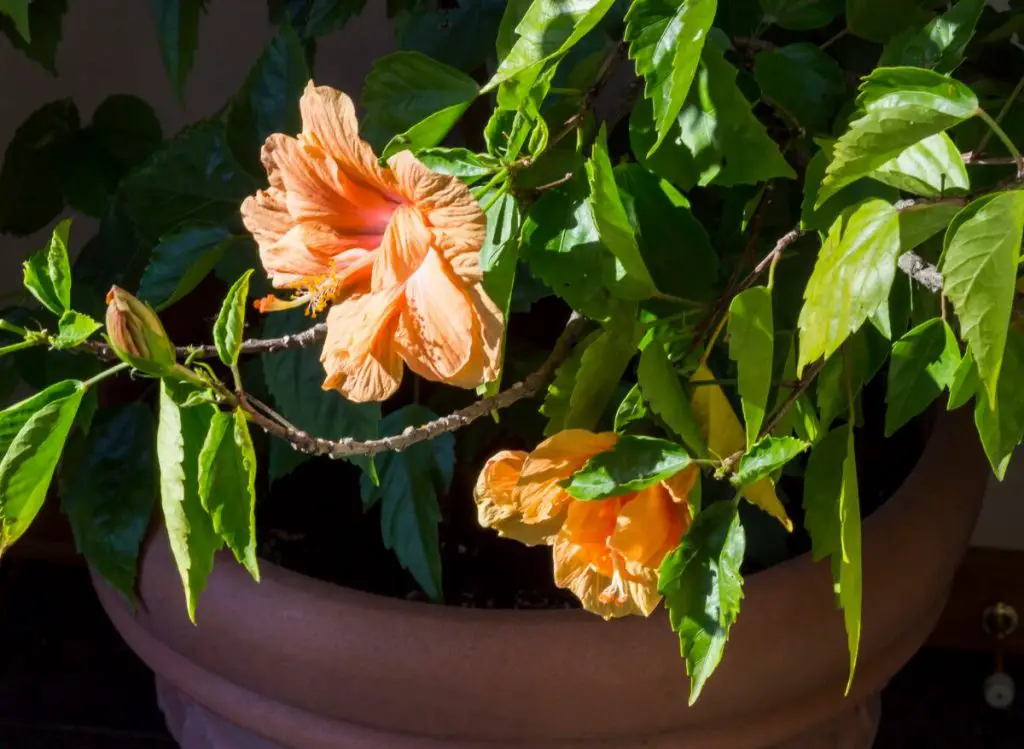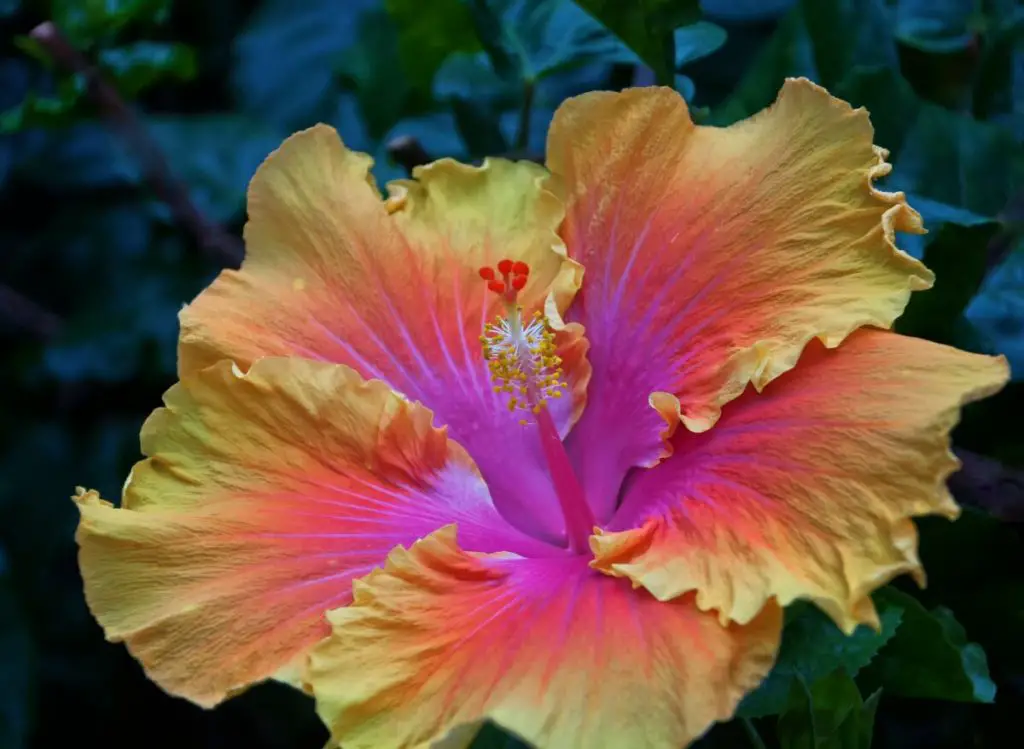Hibiscus, a popular member of the Mallow family of Malvaceae, is one of the most planted flowery plants worldwide. Without proper care, you might find yourself wondering why is your hibiscus not flowering?
Here are some of the common reasons that can prevent hibiscus from flowering:
- Not receiving enough sunlight.
- Fertilizing hibiscus too much.
- Pruning hibiscus at an inappropriate time.
- Not growing your hibiscus plant in the right container.
- Harsh weather conditions.
Like any other plant, the hibiscus plant needs proper attention and care for appropriate results. Without good care, they may stop growing and flowering further.
If your Hibiscus plants are not adequately flowering, don’t worry. There are certain steps you will need to take to improve their chances of flowering. Keep reading on to find out all the reasons that may lead to improper or no flowering of your hibiscus plant and how to make them bloom again.
See also: How Much Water Should You Give Your Hibiscus? (Find out now!)

Why Is Your Hibiscus Not Flowering?
Lots of reasons and carelessness may result in no flowering of hibiscus. Here are some reasons that may cause improper blooming of this plant.
1- Planted in Shadowy Area
Like most the other flowery plant species, hibiscus also needs proper sunlight for proper blooming. If you plant them in a sunny area, they will keep on flowering properly. However, hibiscus’s growth will suffer if your garden is in a shadowy area and doesn’t receive proper sunlight.
To bloom well indoors and outdoors, hibiscus needs need very bright light. If you are growing hibiscus plants indoors, ensure you place them in sunny western or southern exposure with at least 4 to 5 hours of bright, direct sunlight, suggests the University of Minnesota.
Without proper growth, plants generally will not flower properly, which leads to improper blooming, particularly for hibiscus.
2- Overuse of Fertilizers
A reasonable amount of fertilizers helps in the effective growth of the plants. However, if any of the ingredients contained in the fertilizers exceeds, it will affect the plant’s production badly. The same is in the case of hibiscus. If you mistakenly use too much quantity of fertilizers, it will result in improper growth and blooming of the plants.
Nitrogen and phosphorus, in particular, affect the growth of plants. When the number of phosphorus increases in the soil, it prevents the plants from taking other essential nutrients from the soil.
Also, too much nitrogen will result in exposure to vulnerable pests and aphids. So, overuse of fertilizers will also affect the blooming and flowering of hibiscus plants.
- If you grow hibiscus during summertime, use at half the suggested strength every 2 to 3 weeks.
- When growing hibiscus indoors, try to fertilize the plant less often in winter and about half of the suggested strength every month in spring and summer.
See also: Top 6 Electric Kitchen Composters (You need one of these!)
3- Pruning at the Wrong Time
Pruning time affects plants’ growth. If you prune them timely, it will have a positive effect on the plants. However, pruning them at the wrong time of the year will lead to their improper growth. In the case of hibiscus, the wrong pruning time is early spring, particularly if you want them to flower.
If you prune them in the early spring, they will fail to flower in the summer. Wrong pruning is another reason that affects the flowering of the hibiscus.
How To Properly Prune Hibiscus Plants?
- To promote a bushier plant, ensure you prune your hibiscus plants in late winter.
- Generally, hibiscus can resist heavy pruning. Do not hesitate to give your plant a clean haircut, particularly if you want to keep them smaller.
- After pruning, be patient as it will take longer for your hibiscus plants to bloom.
4- Faulty Pots
Hibiscus plants need to be grown in pots featuring proper drainage holes and are narrow. If the soil in which these plants are planted doesn’t drain properly, it will affect the blooming of the plants.
Also, if the drain holes are narrow and the pots feature slow draining, it may result in different diseases. This is another reason for the improper blooming of the hibiscus plants.
The University of Minnesota suggests using a rich, well-drained soil mixture to promote healthy and thriving hibiscus plants.
Tips For Best Potting Mix For Hibiscus:
- Two parts peat moss
- Two parts potting soil
- 1 part perlite or vermiculite
5- Climate Change
You may know, that there are two commonly planted species of hibiscus.
- Hardy hibiscus: Hardy species can tolerate a greater range of temperatures. So, they can flower even in harsh climate conditions.
- Tropical hibiscus: Tropical species, on the other hand, hardly bear any severe climate change.
So, these need to be looked after properly. If you’re struggling to make the wrong species flower in the wrong climate, it may also affect the blooming.
6- Drought Stress
If you forget to water your hibiscus properly, mainly when planted in soil or pots, they may undergo stress caused due to drought.
Also, if the soil you’re using for planting these flowery plants features too many stones or sand, it will lead to instant drainage. This may also cause drought stress that, in turn, will affect the flowering of the hibiscus.
See also: What Are The Differences Between Brassica Flower And Hibiscus Flower?

How to Keep Hibiscus Blooming?
If the hibiscus planted in your garden is not flowering properly, take the following steps to improve their chances of blooming.
1- Provide Them With The Right Temperature.
Proper temperature, particularly for tropical species, is necessary to bloom properly. Hibiscuses thrive in temperatures between 60 and 85°F.
And, generally, at temperatures below 50°F, your plants will stop growing and blooming, leading to smaller and deformed flower sizes.
Also, a freeze and extreme heat will cause Hibiscus plants to die. To avoid this, move your plant indoors before the first fall frost.
2- Check Irrigation
Hibiscus is a thirsty plant that needs to be watered regularly. They need to be watered at least three times a week, even in winters.
In hot summer, water them daily without any break. Also, manage proper water drainage as still water may cause different diseases in them.
See also: 5 Most Common Hibiscus Plant Diseases (You Need to Know About!)
3- Proper Light
Make sure that your hibiscus plants are not planted in the shadow. The more you will expose them to the sunlight, the more they will bloom properly.
Try to move your hibiscus plants to an area where they will receive better sun exposure.
4- Proper Nutrition
Overuse of any nutrient will lead to permanent damage to your hibiscus plants. So, make sure that you don’t use fertilizers in too much quantity.
Generally, Hibiscus plants require a fertilizer with a medium to a high amount of nitrogen (N), a low amount of phosphorous (phosphate (P)), and a high amount of potash (K). For example, you can choose a fertilizer with 12-4-8 or 7-1-2 ratios.
5- Prune Timely
Proper pruning is necessary for the proper growth of all plants. Even though, the best time to prune hibiscus in the United States is in spring or when the weather begins warming up.
However, make sure that you don’t prune your hibiscus plants at the start of spring. If you do so, they will not flower effectively.
Avoid pruning tropical hibiscus in the fall as you risk freezing the new and still tender growth. Bring your tropical hibiscus inside during winter when planted in a container.
See also: Belgian Mums: Annual or Perennial? (Let’s find out!)
How To Properly Care For Hibiscus Plants:
- Hibiscus plants need full sun exposure; southern exposure is perfect for growing hibiscus.
- Excessively fertilizing hibiscus plants might cause the plant to put out lush foliage, usually at the expense of blooms. Four times a year is typically considered very generous.
- Water fluctuations (too much or too little) can cause bud drop. Ensure you check the soil, as hibiscus prefers moist, well-drained soil but not wet soil.
- Most types of hibiscus prefer temperatures between 50 and 90 degrees, and fluctuations above or below the optimum temperatures can cause bud drop.
- More importantly, some varieties are particularly susceptible to bud drop if environmental conditions are not ideal due to extensive hybridization.
How Often Do Hibiscus Bloom?
Hibiscus is an evergreen flowery plant that keeps on blooming in all seasons. Keep in mind that hibiscus plants are generally different from other species that bloom once a year and then you’ll have to wait for the whole year.
How Often To Water Hibiscus In Pots?
In winter, water your hibiscus plants at least two to three times a week. While at the start of summer, do so 3 to 4 times a week. In the peak of summer, water them daily. But make sure that the pots containing hibiscus plants feature proper drainage.
Tips On Watering Hibiscus Plants In Pots:
- Keep your soil relatively moist and not saturated.
- Do not allow the soil to dry out to the point of wilting.
- Ensure you thoroughly water your hibiscus plants from the top of the ground down.
- During the winter months, let the soil dry out slightly more between watering.
See also: How to Make Brassica Plants Flower? (Here’s how)
Wrapping Up
Hibiscus is one of the most loved and most frequently planted species of ornamental plants. The reasons behind its popularity are easy growth and forever blooming.
However, their blooming will suffer if you overlook their proper growth conditions. In any such case, check out the above symptoms and adopt preventive measures accordingly.


